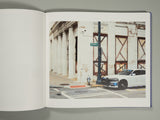The city of Atlanta in the US has endured constant change throughout its history. It has been destroyed and rebuilt several times over, survived slavery and racial segregation to become the cradle of the Civil Rights Movement, and recently recast the state of Georgia as a blue wave in a sea of neighbouring red states. The Makeshift City by Joshua Dudley Greer shows a contemporary Atlanta in a state of flux—both a unique city with a specific history and culture, and a generic American metropolis struggling to forge its identity.
The photographs in the book were made between 2020-2024—a period which encompassed the seismic events of the COVID-19 pandemic, the rise to prominence of Black Lives Matter, struggles for abortion rights, increased income inequality and the Stop Cop City movement. This backdrop provided the motivation for Greer to witness certain economic and political forces as they manifested themselves in the landscape, architecture and community in one of the largest and most progressive cities in the American South. Although the structure of the city changed dramatically during this period, the systems which governed it often remained immutable, constrained by capital interests and the two political parties see-sawing for power.
The images in The Makeshift City document Atlanta’s downtown street corners, suburbs, exurbs, film sets, cemeteries, rivers, and construction sites. They show landscapes ruptured by development and carved by highways, inhabitants improvising outdoor gyms, mosques and offices, sterile new-builds, empty lots and crumbling mansions. Greer weaves together all of these elements into a singular narrative that suggests the tensions of the past and the realities of the present.
‘I watched people go about their daily lives in spite of everything that might act against them. There were times of resilience, activism, selflessness, and joy. But there were also moments of banality, privilege and ignorance, even disdain. I’ve tried to make photographs that acknowledge the totality of experience that may beset one particular place during one particular time. Of course, I know I am unable to do this. There is so much about Atlanta that I don’t understand, and perhaps, probably, never will.’
The region where Atlanta stands today was originally Creek and Cherokee territory. The location was chosen to be a railroad terminus and the city was founded in 1837 as a transport centre. Atlanta was destroyed both in the Civil War by General William T. Sherman’s troops and again in a great fire of 1917—the mythical Phoenix rising from ashes adopted as the city’s official symbol. Throughout its history, Atlanta’s layout and growth was shaped and influenced by slavery, racial discrimination and segregation. And yet, Atlanta also became known as ‘The Black Mecca’ for its thriving Black businesses, political leadership, higher education and entertainment. Atlanta’s current population growth, real estate development and racialised gentrification set the stage for a new chapter, one that sits within an uneasy political era pointing toward an uncertain future.
December 2024
290 x 260 mm portrait
144pp, 69 images Hardback
ISBN: 978-1-915423-58-0
























